Don Bosco
Don Bosco as Father and Teacher
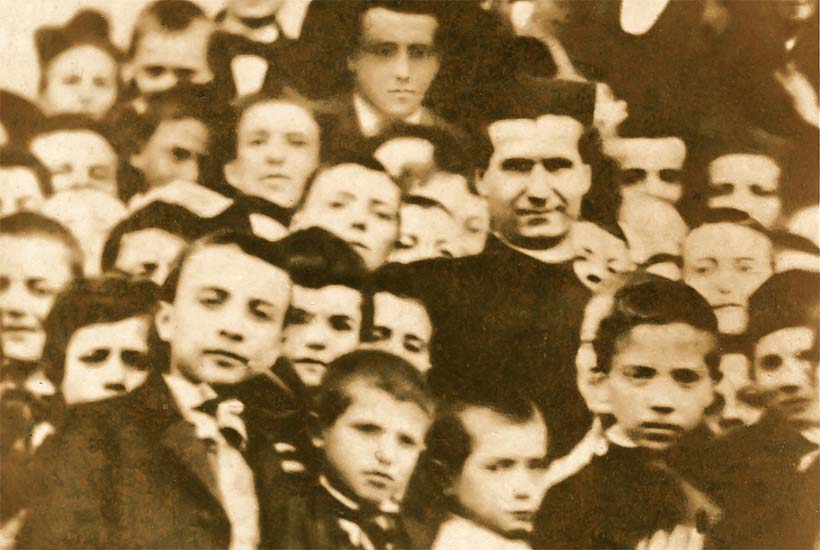
The Lord has given us Don Bosco as father and teacher.
We study and imitate him, admiring in him a splendid blending of nature and grace.
He was deeply human, rich in the qualities of his people open to the realities of this earth; and he was just as deeply the man of God, filled with the gifts of the holy Spirit and living “as seeing him who is invisible”.
These two aspects combined to create a closely-knit life project, the service of the young.
He realized his aim with firmness constancy and the sensitivity of a generous heart, in the midst of difficulties and fatigue.
“He took no step, he said no word, he took up no task that was not directed to the saving of the young…Truly the only concern of his heart was for souls. ” (the words of Michael Rua, his first successor)
(Source: C. 21)
History of Don Bosco
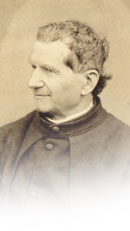
Early years and eventual priesthood
John Bosco was born at Castelnuovo d’Asti on 16 August 1815, of a family of peasant farmers. His father, Francis Bosco, died when John was just two, and Margaret Occhiena found herself bringing up Anthony, Joseph and John alone.
With firm kindness and unbounded faith Margaret, wise educator that she was, made her family into a domestic church.
From when he was small, John began to feel a desire to become a priest. he spoke of having had a dream at nine years of age, which revealed to him his mission: “Make yourself humble, strong and robust”, a woman resplendent as the sun told him, “and what you see happening to these wolves which change into lambs, you will do for my children. I will be your teacher. In time you will understand”. While still a lad, John began to do magic tricks, learned with hard effort, for his friends, and he alternated this with work and prayer.
The elderly Fr Calosso started him off with his studies for the priesthood, studies that cost him effort, to the point where he had to leave home because of his brother anthony’s opposition. He wanted John to work in the fields.
As a seminarian at Chieri, he thought up the idea of the ‘Cheerful Society, which gathered boys from around the town. In June 1841 he was ordained priest. His spiritual director, Fr cafasso, advised him to complete his studies at the Ecclesiastical Institute. Meanwhile Don Bosco gathered his first boys around him, and organised a festive oratory, initially on the move but then stabilised at Valdocco. Margaret, by now elderly, accepted to come to Turin and help him, and become ‘Mamma Margaret’ for the boys.
Preventive system
Don Bosco began to give a place to boys without a home to go to. He taught them to work, and to love the Lord; he sang, played and prayed with them. With the first boys came his first helpers. Thus he developed his famous educational method, the Preventive System. “Be with the boys, prevent sin through reason, religion and loving kindness. Become saints and educators of saints. Our boys must know they are loved”.
Over time the first helpers, with the help of Pope Pius IX, became a Congregation aimed at the salvation of the young, fighting all forms of poverty and taking as its own the motto: “Give me souls, take away the rest”.
Young Dominic Savio is the first fruit of the Preventive System. Mary Help of Christians, who always supported Don Bosco in his work, obtained many graces for him, even extraordinary ones, as well as the funds necessary for his enterprises. She helped him build the Basilica which bears her name.
Salesian Sisters and Salesian Cooperators
With the help of Saint Mary domenica Mazzarello, he founded the Institute of the Daughters of Mary Help of Christians. With benefactors and committed lay people he gave life to the Salesian Cooperators.
Don Bosco died exhausted from work at age 72, on 31 January 1888. Today the Salesian Family is throughout the world.
Pope John Paul II declared him ‘Father and Teacher of Youth’ on the centenary of his death.
The Young People's Priest
It is enough for you to be young for me to love you very much
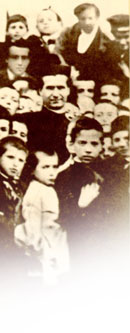
Young John Bosco was born on 16 August 1815 in a small hamlet of Castelnuovo D’Asti, in Piedmont, popularly called “The Becchi”.
While he was still a child, his father’s death made him experience the pain of so many poor orphans for whom he would become a loving father. However, he founa an example of a Christian life in his mother Margaret that left a deep impression on his soul.
At nine years of age he had a prophetic dream: he seemed to be in the midst of a multitude of children intent on playing, some of whom, however, were swearing. Immediately, young John jumped amongst them using his words and fists to silence them; but then a dignified man appeared who said to him: “You will have to win these friends of yours not by blows but by gentleness and love … I will give a teacher. Under ger guidance you can become wise. Without her all wisdom is foolishness. ” This dignified man was Jesus and the teacher Mary, to whose guidance he gave himself throughout his life and whom he honoured with the title of “Help of Christians”.
So it was that John sought to learn how to be an acrobat, a magician, a singer, a juggler in order to attract his companions to himself and keep them away from sin. “If they stay with me,” he told his mother, “they don’t speak badly.”
Wanting to become a priest, to devote himself entirely to the salvation of children, while he worked during the day, he spent his nights with his books, until at the age of twenty he was able to enter the seminary in Chieri and be ordained a priest in Turin in 1841, at twenty-six.
In those times Turin was filled with poor orphaned or abandoned boys looking for work, exposed to many dangers to soul and body. Don Bosco began to gather them on Sundays, sometimes in a Church, sometimes in a meadow, or in a square to let them play and so he could instruct them in the Catechism until, after five years of enormous difficulties, he managed to settle on the outskirts of Turin at Valdocco and open his first Oratory.
There the boys found food and lodging, studied or learned a trade, but above all they learned to love the Lord: Sainyt Dominic Savio was one of them.
Don Bosco was very much loved by his “rascals” (as he called them). To those who asked him the secret of his ascendancy over them he replied: “With kindnessand love I try to win these friends of mine over to the Lord.” For them he sacrificed all the little money he possessed, his time, his ingenuity, his health. With them he became a saint. For them he founded the Salesian Congregation made up of priests and lay people who want to continue his work and to whom he gave as their “main purpose to support and defend the Pope’s authority”.
Wanting to extend his apostolate to girls as well, with Saint Mary Domenica Mazzarello he founded the Institute of the Daughters of Mary Help of Christians.
The Salesians and the Daughters of Mary Help of Christians have spread throughout the world and are at the service of the young, the poor and the suffering, with schools at every level, technical and professional institutes, hospitals, dispensaries, oratories and parishes.
He dedicated all his free time, often stealing hours of sleep, to write and spread easy to read pamphlets for the Christian education of the people.
In addition to being a man of very active charity, he was one of the great mystics.
All his work originated from his intimate union with God. From his youth he jealously nurtured and developed a filial abandonment to God and was faithful to the plan that God had prepared for him, guided step by step by Mary, who was the Inspirer and Guide of all his work.
But his perfect union with God was, perhaps like few saints, combined with so much human goodness, intelligence and balance, to which we can add the merit of an exceptional knowledge of the soul, an understanding that had matured over long hours spent daily in the ministry of confession, adoration of the Blessed Sacrament and in continuous contact with young people and people of all ages and conditions.
Don Bosco formed generations of saints because he called his young people to the love of God, the reality of death,God’s judgement, the existence of Heaven and Hell, the need to pray, avoid sin and the occasions of sin, and to approach the Sacraments frequently.
“My dear boys, I love you with all my heart, and it is enough for you to be young for me to love you very much”. He loved them in such a way that each one felt he was especially loved.
“You will find writers far more virtuous and more learned than I, but you can hardly find anyone who loves you more than I do in Jesus Christ, or who desires your true happiness more than I do.”
Exhausted by his tireless work, early on he fell seriously ill. A moving detail: many of his young people offered their lives to the Lord on his behalf “… What I did, I did for the Lord … More could have been done … But my children will do this work.”
Before his death many years later, one of his recommendations was this: “Tell the young people that I am waiting for them in Heaven … .”
He died on 31 January 1888 in his poor room at Valdocco, at 72 years of age.
On 1 April 1934, Pius XI, who had had the good fortune to know him personally,proclaimed him a Saint.
First Dream
In good time you will understand everything
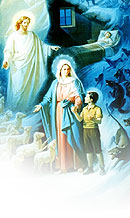
It was at that age (9) that I had a dream. All my life this remained deeply impressed on my mind. In this dream I seemed to be veyr near my hoime in a very large yard. A crowd of children were playing there. Some were laughing, some were playing games, and quite a few were swearing. When I heard these evil words I jumped immediately amongst them, and tried to stop them by using my words and my fists.
At that moment, a dignified man appeared, a nobly-dressed adult. He wore a white cloak and his face shone so that I could not look directly at him. He called me by name, told me to take charge of these, and added these words:
“You will have to win these friends of yours not by blows but by gentleness and love. Start right away to teach them the ugliness of sin and of the beauty of virtue.” Confused and frightened, I replied that I was a poor, ignorant child. I was unable to talk to those youngsters about religion. At that moment, the kids stopped their fighting, shouting and swearing; they gathered around the man who was speaking.
Hardly knowing what I was saying, I asked, “Who are you, orderingr me to do the impossible?”
“Precisely because it seems impossible to you, you must make it possible through obedience and the acquisition of knowledge.”
“Where, by what means can I acquire knowledge?”
“I will give you a teacher. Under her guidance you can become wise. Without her all wisdom is foolishness. “
“But who are you that speak so?”
“I am the son of the woman whom your mother has taught you to greet three times a day.”
“My mother tells me not to mix with people I don’t know, unless I have her permission. So, tell me your name.”
“Ask my mother what my name is.”
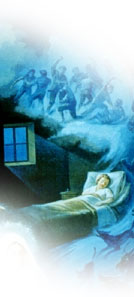
At that moment, I saw beside a lady of stately appearance standing beside him. She was wearing a mantle that sparkled all over as though covered with bright stars.. Seeing from my questions and answers that I was more confused than ever, she beckoned me to approach her. She took me kindly by the hand and said:
“Look.”
Glancing round, I realised that the youngsters had all apparently run away. A large number of goats, dogs, cats, bears and other animals had taken their place.
“This is the field of your work. Make yourself humble, strong and energetic. And what you wil see happening to these animals, you must do for my children.”
I looked around again, and where before I had seen wild animals, I now saw gentle lambs. They were all jumping and bleating as if to welcome than man and lady.
At that point, still dreaming, I began crying. I begged the lady to speak so that I could understnd her, because I did not know what all of this could mean. Then she put her hand on my head and said:
“In good time you will understand everything.”
With that, a noise woke me up and everything disappeared.
I was totally bewildered. My hands seemed to be sore from the blows I had given and my face hurt from those I had received. The memory of the man and the lady, and the things said and heard, so occupied my mind that I could not get any more sleep that night.
A Fascinating Saint
Staying with Don Bosco

Among the factors contributing to our unity as a Congregation and Salesian Family, the first and most powerful is love for Don Bosco. It is an empathy, an admiration, a feeling, an attraction, a kind of instinctive energy which leads to his imitation, the desire to remain with him spiritually and be involved in his work.
We know that grace is at the origin of our vocation. By directing us to Don Bosco as our Father, Teacher and Friend, the Holy Spirit has led us to the religious consecration characterized by his mission to the young and his educative concern.
In salesian tradition our affection has always been manifested without shame, almost with youthful enthusiasm, prolonging the admiration of the first young oratorians who wanted ‘to stay with Don Bosco’ and formed the first nucleus of the Congregation. It is the sign of a filial rapport which is deeply felt.
From the Salesians this enthusiasm and admiration passes in the first place to the youngsters themselves, who express it in many forms according to their style: with songs, scenarios, T-shirts, celebrations, pilgrimages, reading of some biography, presentation of films and videocassettes, pleasure at being in or linked with our houses, friendship with confreres: a common collection of songs and hymns which by now has spread around the world and is heard in every language.

I have seen at first hand two results of this affection. In the young it gives rise to initiatives, thoughts, desires and projects in the line of commitment and growth in faith; it is a powerful vocational factor. In the communities it is a source of joy, of confidence in our work, of serene identification and membership. Even in cases in which a critical observer might discern a bit of ingenuity or exaggeration the results are positive. Coldness and detachment, on the other hand, seem entirely unproductive.
The admiration is not confined to our own environment. We hear comments, necessarily of a general kind, about the genius and originality of Don Bosco in ecclesial circles, from civil authorities and from ordinary people. Many expectations rely on the application of his methods and on the setting up of educative initiatives like those to which he gave origin.
I found interesting the study on the formation of Don Bosco’s image. It was certainly influenced by the adherence of his youngsters, who had been won over by his ability to love them and open them to life. They collected and spread anecdotes, dreams and enterprises with extraordinary narrative verve when modern means of communication were nonexistent. As they passed on their experiences, they seemed almost to bring the fascinating fatherliness of Don Bosco to life again. It is something that has remained among our charismatic and pastoral characteristics: the enthusiastic love for the Founder and its communication to the young.
It was also influenced by the manner in which his enterprises were presented by the Salesian Bulletin, under his direction and in line with his own criteria. Good was to be spread and presented in an attractive way.
But especially it was influenced by the direct impact of the style and educative results in a society becoming more and more concerned with the phenomenon of youth.

At the origin is a typical holiness, marked by pastoral charity capable of reaching a person?s heart and attentive to the questions of his time. Congar, in a well known comment on the Council, referred to Don Bosco in these terms: “The greatest novelty of the Council lies in this: if the Church is in the world and in the world there are problems, then holiness is a phenomenon which is of concern to culture. This may seem a debatable concept, but a central point of the Council’s intuitions is that there is a connection between holiness and history.” With the Incarnation human history becomes the place where the love of God is expressed; holiness therefore is not born of flight from the world or its rejection, because it is in the measure that I immerse myself in the world to save it that I find the great gift of God.
Who are the saints? I like to recall in the first place one who preceded the Council by a century: Don Bosco. He was prophetically a new model of holiness through his work which distinguished him from his contemporaries manner of thinking and judging.
‘We study and imitate him’, say the Constitutions. The two seem linked together. Today a great deal is said about creative fidelity with respect to consecrated life. A serious approach and renewed attention in this sense not only takes nothing from the image of our Father, embellished by affection and by a tradition which has kept the memory of his deeds alive, but endorses the validity of his permanent place in the historical and ecclesial context.
(ACTS 364 Fr Vecchi)
Resources
Beatified 2-6-1929
Canonised 1-4-1934
At Becchi, then as a seminarian in Chieri
John Bosco was born in Castelnuovo d’Asti on 16 August 1815 of a peasant family.
His father, Francis Bosco, died when John was two, and Margaret Occhiena found herself raising Anthony, Joseph and John on her own.
With kindly firmness combined with boundless faith, Margaret, a wise educator, made a domestic church of her family.
John began to feel the desire to become a priest from an early age. He told of having had a dream at nine years old, which revealed his mission to him: “Make yourself humble, strong and energetic,” a woman as resplendent as the sun told him, “and what you will see happening to these animals in a moment is what you must do for my children. I will teach you. In time, you will understand everything. ” Since he was a boy, John had begun to entertain his companions with magic tricks, learned through hard training, alternated with work and prayer.
The older Fr Calosso helped him begin his studies with a view to the priesthood, which he had to face with difficulty until he left home due to opposition from his brother Anthony. He wanted John to work in the fields.
As a young student in Chieri, he started, the Society for a Good Time which brought together young people from the town. In June 1841 he was ordained a priest. His spiritual director, Fr Cafasso, advised him to perfect his studies at the Convitto ecclesiastico or Pastoral Institute.
The Preventive System
Meanwhile, Don Bosco gathered the first boys around him, and organized a festive (weekend) oratory, which initially moved from place to place but ultimately settleed at Valdocco. Margaret, now a much older woman, agreed to come to Turin to help him and became “mamma Margaret” for the boys.
Don Bosco began to provide shelter to homeless orphans. He taught them a trade and to love the Lord. He would sing, play and pray with them.
The first co-workers also came from among these first boys. Thus his educational method developed, the famous “Preventive System”: “Stay with the boys, prevent them from sinning with reason, religion and loving kindness. Become saints, educators of saints. Let our boys realize they are loved. ” Over time, thanks also to the help of Pope Pius IX, these first helpers of his became a Congregation that aims at the salvation of youth, fighting every kind of poverty. Its motto became “Give me souls, and take away everything else.”
The young Dominic Savio is the first fruit of the preventive system. Mary Help of Christians, who always supported Don Bosco in his work, obtained numerous graces, including extraordinary ones, and the money needed for all his enterprises. She also helped him build the Basilica by the same name.
The Daughters of Mary Help of Christians, The Salesian Cooperators
With the help of Saint Mary Domenica Mazzarello he founded the Institute of the Daughters of Mary Help of Christians. Together with his benefactors and committed lay people he created the Salesian Cooperators.
Don Bosco died, exhausted by all his work, at 72 years of age on 31 January 1888. Today the Salesians are present throughout the world, and he has been recognized by the Church as “father and teacher of the young”.
Pius XI, who had known him, beatified him in 1929 and canonized him on Easter Sunday, 1 April 1934.
for more … Resources in general
Africa-Madagascar
Don Bosco - CIVAM
Pepo Lane, Karen
P.O. Box 2, 00502
Karen, Nairobi
+254733241785
Don Bosco CIVAM
services
Resources
Copyright © 2024. All rights reserved.















